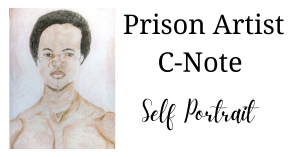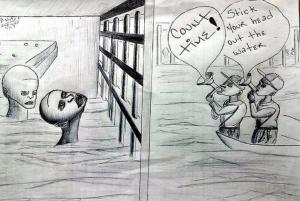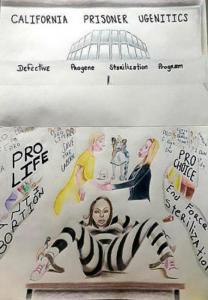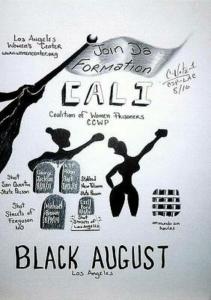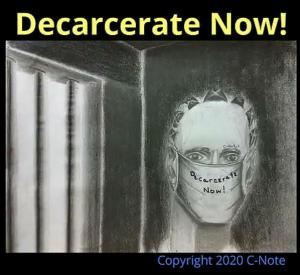Newly released self-portrait print of American prison artist Donald “C-Note” Hooker is being made available to the public to own.
OAKLAND, CALIFORNIA, UNITED STATES, December 30, 2022 /EINPresswire.com/ — With just 4% of the world’s population, but 25% of its prison population, a population large enough to be the fourth largest US city, these statistics are not what you would want to be known for, as the freest nation on Earth.
Prisons are not locations hospitable to the free flow of information, and that includes its insides. Sometimes it requires the artist’s rendition to see inside these restricted places.
For example, after the news reporting in 2017, on Category 5 Hurricane Harvey in Texas, California prison artist Donald “C-Note” Hooker created a work called “During the Flood.” The title, “During the Flood,” was specifically chosen over naming the piece specific to Hurricane Harvey. There will be other floods in other parts of the country.
“During the Flood” would become one of C-Note’s most disseminated works, and this was even before the role it played as a Public Service Announcement by grass roots organizations advocating for the evacuation of prisons in the path of Category 5 Hurricane Dorian in 2019, and utilized again as a PSA by grass roots to evacuate prisons in the path of Category 4 Hurricane Ida in 2021.
SELF PORTRAIT
According to the Associated Press (AP) headline in 1998, “Calif. Prisons To Remove Weights,” the AP wrote, “In a reversal of a trend dating to the 1960s, California prisons are moving to eliminate privileges such as access to weight-training equipment and tighten up appearance standards.
Plans are also in the works to remove law books inmates use to challenge their confinement.
“We got into the position at one juncture of providing a rather comfortable lifestyle in prison,″ said Sean Walsh, Gov. Pete Wilson’s spokesman. “We should not allow prisoners to ride roughshod over the prisons.″
The moves come as officials issue warnings about crowding in California’s 33 prisons, and as prisoners and their advocates say a tense atmosphere behind the walls is getting worse.
One month ago, officials began enforcing new grooming standards that require men’s hair to be closely cropped, a measure that prompted at least 100 inmates at Folsom Prison to stage a hunger strike on New Year’s Day.
“It’s all part of a comprehensive review of prison operations,″ said Tom Maddock, head of the Youth and Adult Correctional Agency. Among other steps planned this year, Maddock said prison officials plan random drug tests for inmates and will prohibit packages from being sent directly to inmates.
A program is also afoot to require all inmates to wear white jumpsuits, instead of blue jeans and blue work shirts, thus making it more difficult for escapees to blend in, officials say.
Prisoners’ rights advocates, inmates and relatives have long criticized the Department of Corrections for what they consider its punitive approach, but these latest changes are drawing criticism from within the system.
“We’re going to drag them out of their drum cells and shave their heads?″ asked Don Novey, president of the California Correctional Peace Officers Association, the guards union. “The irony of it. You’re massively overcrowded. You’re understaffed. … It’s stupid. But it resonates with the public. We get this perception that we’re tough with the pedophiles.″
Matthew Jay, 30, serving 15 years to life at Solano State Prison for second-degree murder, is one of thousands of prisoners whose home is a bunk in a prison gym. Lifting weights is one of the few pastimes that relieves frustration, he said; without them tensions will rise.
But he’s more worried about the potential loss of law books.
“If that access is taken away, we are no longer in a prison. We are in a war camp, like a prisoner of war,″ Jay said. “When rights are violated, we’re left with no alternative but to react. We want to prevent that.″
California prisons had been under a 1972 federal court order to maintain full law libraries. Citing a 1996 U.S. Supreme Court decision allowing prisons to limit law libraries, the state Department of Corrections persuaded U.S. District Judge Susan Illston in San Francisco to lift the 1972 injunction, opening the way for the department to remove most law books.”
According to the California Legislative Analyst’s Office, “As of January 31, 2000 state prisons were at about 195 percent of their design capacity.” This severe overcrowding would lead to a 2011 decision by a conservative US Supreme Court to order California to release 30,000 prisoners, because of its extreme overcrowding had horrible consequences, including deaths, in violation of the 8th Amendment to the US Constitution’s Cruel and Unusual Punishment Clause. See Brown v. Platt.
It was during this era of California prisoner #K94063, Donald “C-Note” Hooker’s young Three Strikes sentence in 1998, that on January 1, 2000, he and other African Americans found themselves in solitary confinement after a riot with prison guards, at a prison the AP would later report on in a 2015 headline “Report: Alarming abuses seen at remote California prison,” and the Washington Times headlined, “State report finds ‘culture of racism,’ alarming abuses at remote Northern California prison.”
These reports were based on a California Inspector General finding. It was at this time, C-Note decided to take up drawing, as opposed to continuing on as a poet and writer of Rap lyrics.
Included in this era from 1998, during the whole of the 2000s saw the banning of prisoners being allowed to take photos at yard time. The new rules permitted only prisoners who received a visit could take photos, breaking with a long tradition of allowing prisoners to take photos of themselves and with others.
Since most prisoners did not receive visits, especially at a remote prison as C-Note was from 1998 – 2011, High Desert State Prison (HDSP), he had to draw a self portrait of himself, so that the people he was meeting through correspondence had an idea, what he looked like.
OTHER NOTABLE WORKS
In 2017, while listening to Los Angeles Public Radio Station KCRW local news program Press Play, hosted by Madeleine Brand, the topic was reparations for forced sterilization in California. In 1909, California had legalized forced sterilization, and from 1909-1979, over 20,000 sterilizations had taken place. 1919-1953, the majority of sterilizations were forced upon Californians with Spanish surnames.
Despite repealing the 1909 law in 1979, from 2006-2010, 150-women prisoners were forcibly sterilized. This particular episode was about righting the wrongs of California’s Eugenics program by providing reparations. The episode served as a Public Service Announcement (PSA), to inform the public the State of California had reparations funds.
Conspicuously absent from these reparations talks were the women prisoners. Their exclusion caused C-Note to create the 2018 paintoem “Today We Are Sisters.”
Paintoems are poems inspired by paintings or drawings; or paintings and drawings inspired by poems. They are combined together as a single work of Digital art. All paintoems are classified as a Creative Commons (CC). This means the public has the right to freely use these works as long as the artist or artists are acknowledged.
“Today We Are Sisters,” was a work of art to unify the political divide amongst the sisterhood for the cause of the reproductive rights of women prisoners. Here is the poem C-Note created in conjunction to the artwork:
TODAY WE ARE SISTERS
Today we are sisters
Tomorrow we won’t
unless for reparations
together we fight
I am Pro Choice
I am Pro Life
just because she’s in prison
She still has rights
In the publication Mprisond Poetz, C-Note notes, “Me being an absolutely stupid guy, and using my observations, women are very catty, and they themselves are always discussing how they don’t support one another. This is why the piece is called Today We Are Sisters. Because no matter what side of the abortion debate you are on, forced sterilization is anti Pro-Life, and is anti Pro-Choice.”
That year, 2018, C-Note donated the drawing “Today We Are Sisters” to the California Coalition for Women Prisoners (CCWP). The CCWP is a grassroots organization involved in the advocacy for women imprisoned in California.
Every year since 2018, the CCWP had begun advocating to California legislators for reparations to victims of California’s illegal eugenics program that had been practiced on its women prisoners. Other advocates also began to lobby California legislators for these reparations.
In 2020, Erika Cohn released Belly of the Beast, a seven year project on the forced sterilization of California women prisoners. However, it wasn’t until shortly after the February 2021, release of Free Virtual Art Exhibition (1-Artist; 1-Subject; 21-Works), which concluded with Today We Are Sisters, that California legislators acquiesced to grass roots’ demands, and put forth a Bill to give California women prisoners who were forcibly sterilized reparations.
In July of 2021, California Governor Gavin Newsome signed into law AB 1007, Forced or Involuntary Sterilization Compensation Program, $7.5 million reparations Bill. As a result, California became the first state in the nation to compensate survivors of prison sterilization.
BLACK AUGUST – LOS ANGELES
Black August — Los Angeles (2016), is a work of Ink on paper. It is a work that was inspired by the month long Black August celebrations that were taking place in Los Angeles in 2016. C-Note first heard of these on the independent, publicly supported radio KPFK, and the Saturday morning program “Think Outside the Cage.”
Started in the 1970s by Black prisoners in San Quentin as a remembrance due to the state sanctioned killing of prisoners for demanding Humane treatment. It has long since been internationally recognized, and in 2022, it was headlined in the AP, “Black August Uplifted as Alternative Black History Month.”
Black August — Los Angeles was C-Note’s first attempt at Political Art. It makes reference to Beyonce’s Formation; the death of prisoners, and prison reform activists, George Jackson, and Hugo “Yogi” Pinell. Both men were murdered in prison. Police shooting death victims, Michael Brown, and Ezell Ford. These kinds of deaths had reawakened America’s consciousness on its criminal justice system, thus prison reform. The California Coalition of Women Prisoners (CCWP), so that the public doesn’t forget we imprison women too. The Los Angeles Women’s Center, to bring public consciousness, and hopefully funding, to a place that provides services and refuge to women, most likely from the same environmental milieu as those who have been, or will become imprisoned. The Raised Fist, a symbol of Black Power during the Civil Rights Movement of the 1960’s. Now a symbol of empowerment during any struggle. And “Mundo Sin Jaulas” (A World Without Cages), in recognition of the Brown People’s Movement.
Black August – Los Angeles is now free for the public to use under a Creative Commons share alike license, and is published in the Wikipedia article, “Black August (commemoration).”
DECARCERATE NOW!
In 2020, C-Note was asked by Oakland, California based Hip Hop Rapper and Artivist Min King X aka Pyeface, to create a work of art for his music video “Mask Protest.” Although never released, the concept came about during the George Floyd mass protest in the summer of 2022. Later, C-Note would design a poster from the original art drawing. Conspicuously drawn above the facing right eye is a tattoo with the word C-Note. It too is very much viewed as a self portrait by the prison artist.
WHO IS C-NOTE?
Donald Oliver Hooker (born December 13, 1965), better known by his street name, C-Note, is an interdisciplinary American Prisoner Artist. A poet, playwright, painter, performing artist, and the King of Prison Hip Hop, his works have either been exhibited, recited, performed, or sold, from Alcatraz to Berlin.
C-Note was born as an orphan in Los Angeles, California. He was adopted by an African American married couple, Clavie and Paulette (Washington) Hooker, and was their first child. Later, they would adopt another boy they named Douglas, a younger sibling whose mother was white and father Black. Eventually, the couple would have their own child, a girl they named Dion. When C-Note was eight; Douglas, seven; and Dion, six; she died of a brain tumor.
According to a 1999 court briefing document, filed by his attorney in the Second District of the California Court of Appeals, C-Note received a prison sentence of 35 years to life for pulling out a knife in the skid row area of Los Angeles, and holding it in a threatening manner to prevent a homeless person from following him. See People v. Hooker. Appeal No. B122970, California Court of Appeals, Second Appellate District. 1999, Opening Brief.
C-Note drew local attention in the late 80s while an inmate in the Los Angeles County Men’s Central Jail, when he sat down for two televised interviews as a part of investigative reporting by then independent Los Angeles broadcast station KCOP-TV. The first investigation involved Cross burning by white officers inside the jail’s Crips gang housing units. Over a year later, he was one of a number of people interviewed on a televised special regarding the gangs in Los Angeles.
As a prisoner artist, he first came to prominence as Money Mike; the lead character in the 10-minute play, Birth of a Salesman. A play in which he both wrote and starred. Birth of a Salesman was the opening act to the critically acclaimed play, Redemption in Our State of Blues. Redemption was performed at the California State Prison, Los Angeles County in December 2015, and encored in March 2016.
In the intervening years, his works have either been exhibited, recited, performed, or sold, from Alcatraz to Berlin. Despite being incarcerated as a general population prisoner in a maximum-security prison, the media has either filmed, photographed, quoted, or written about him in People; ABC Los Angeles (KABC-TV); Museum of Contemporary Art, Los Angeles’s Artbound; Inside CDCR; Darealprisonart; San Francisco Bay View; KCET’s Departures; The London Daily Post; Middle East Headlines; The Good Men Project; Da Real Hip Hop News; Muzique Magazine; and during Super Bowl LVI held in Los Angeles, was interviewed by international Hip Hop scholar Kim Dankoor of the Netherlands.
He also has been a contributing writer or visual artist to California Prison Focus; Prison Action News; Mprisond Thotz; Hamilton College’s, American Prison Writing Initiative; John Jay College of Criminal Justice, Prisoner Reentry Institute’s, Our Voice; The Real Cost Of Prison; Los Angeles Tribune; and Prison Journalism Project …
In 2017, Google Search listed him first in search results as both America’s, and the world’s most prolific prisoner artist.
To learn more about C-Note and his works as a visual artist, visit the Darealprisonart webpage Prisoner-Artist C-Note Wall Art. There, you’ll find his self portrait, along with nearly 200 works by this prison artist.
DAREALPRISONART is the largest multimedia source of prisoner news and art across multiple web platforms. It provides over 10,000 art print products of Prison Art, the most influential Art movement in the United States.
Clyde Daniels
Darealprisonart
+1 323-825-4014
email us here
Visit us on social media:
Facebook
Twitter
Instagram
YouTube
Other
![]()


